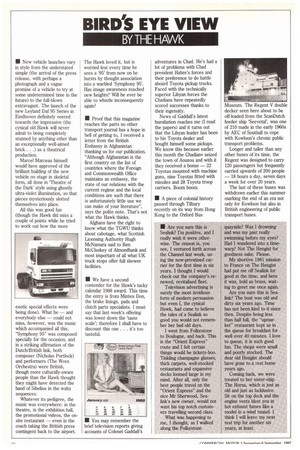• New vehicle launches vary in style from the understated
Page 58

If you've noticed an error in this article please click here to report it so we can fix it.
simple (the arrival of the press release, with perhaps a photograph and a vague promise of a vehicle to try at some undetermined time in the future) to the full-blown extravagant. The launch of the new Leyland Daf 95 Series in Eindhoven definitely veered towards the impressive (the cynical old Hawk will never admit to being completely stunned by anything other than an exceptionally well-aimed brick . . .) as a theatrical production.
Marcel Marceau himself would have approved of the brilliant building of the new vehicle on stage in skeletal form, all done in `Theatre of the Dark' style using ghostly ultra-violet illumination, so that pieces mysteriously slotted themselves into place.
All this was good fun (though the Hawk did miss a couple of points while he tried to work out how the more exotic special effects were being done). What he — and everybody else — could not miss, however, was the music which accompanied all this. "Symphony 95" was composed specially for the occasion, and in a striking affirmation of the Dutch/British link, both composer (Nicholas Portlock) and performers (The Wren Orchestra) were British, though more culturally-aware people than the Hawk thought they might have detected the hand of Sibelius in the waltz sequences.
Whatever its pedigree, the music was everywhere: in the theatre, in the exhibition hall, the promotional videos, the onsite restaurant — even in the coach taking the British press contingent back to the airport. The Hawk loved it, but is worried lest every time he sees a '95' from now on he bursts by thought association into a warbled 'Symphony 95'. Has image awareness reached new heights? Will he ever be able to whistle inconsequently again?
• Proof that this magazine reaches the parts no other transport journal has a hope in hell of getting to, I received a letter from the British Embassy in Afghanistan thanking us for our publication. "Although Afghanistan is the first country on the list of countries where the Foreign and Commonwealth Office maintains an embassy, the state of our relations with the current regime and the local conditions are such that there is unfortunately little use we can make of your literature", says the polite note. That's not what the Hawk thinks.
Afghans have the right to know what the TGWU thinks about cabotage, what Scottish Licensing Authority Hugh McNamara said to Ben McCluskey of Almondbank and most important of all what UK truck stops offer full shower facilities.
• We have a second contender for the Hawk's tacky calendar 1988 award. This time the entry is from Mintex Don, the brake linings, pads and dutch parts specialists. I must say that last week's offering was lower down the 'taste scale'; therefore I shall have to discount this one. . . it's too tasteful. adventures in Chad. He's had a lot of problems with Chad president Habre's forces and their preference to do battle aboard Toyota pickup trucks. Faced with the technically superior Libyan forces the Chadians have repeatedly scored successes thanks to their ingenuity.
News of Gaddafi's latest humiliation reaches me (I read the papers) and it turns out that the Libyan leader has been to his Toyota dealer and bought himself some pickups. We know this because earlier this month the Chadians seized the town of Aouzou and with it they received a bonus — 22 Toyotas mounted with machine guns, nine Toyotas fitted with missiles and 28 Toyota troop carriers. Boom boom.
• A piece of colonial history passed through Tilbury recently on its way from Hong Kong to the Oxford Bus Museum. The Regent V double decker seen here about to be off-loaded from the ScanDutch feeder ship `Seevetar, was one of 210 made in the early 1960s by AEC of Southall to cope with Kowloon's chronic public transport problems.
Longer and taller than any other buses of its time, the Regent was designed to carry 120 passengers but frequently carried upwards of 200 people — 18 hours a day, seven days a week for over 20 years.
The last of these buses was withdrawn earlier this summer marking the end of an era not only for Kowloon but also in British engineering of public transport buses.




























































































